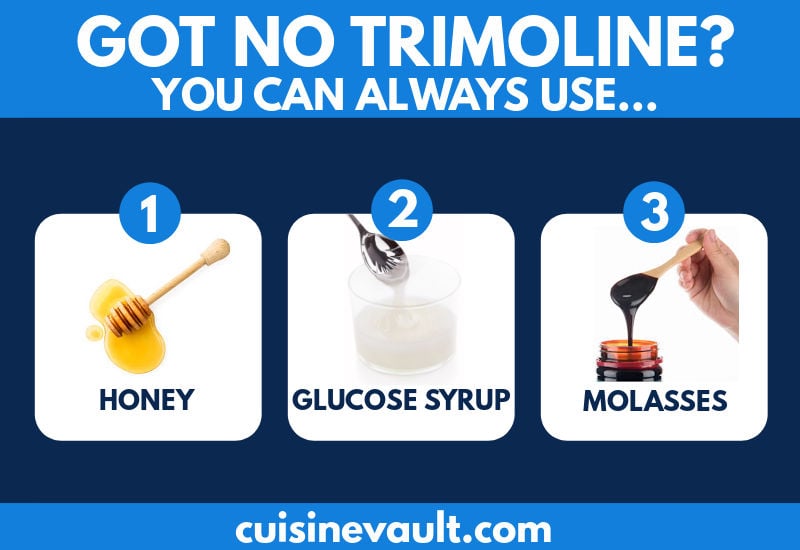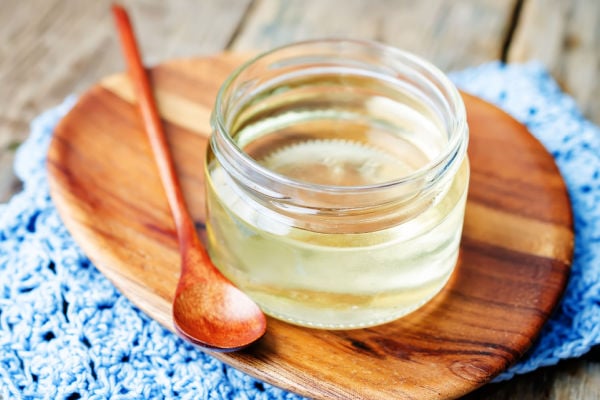Trimoline is an invert sugar that is very sweet with a thick, viscous texture. Used by professional bakers and pastry chefs, it is a useful ingredient for helping prevent crystallization. Trimoline gives ice cream and sorbet a pleasant creamy texture and encourages smooth ganache and candy. Cookies gain a chewy and moist crumb and also benefit from a longer shelf life.
As home cooks become more adventurous with their use of ingredients, products like trimoline are popping up in more recipes. If you can’t get your hands on the product, or you’d prefer to use an alternative sweetener, keep reading. We’ve created a selection of trimoline substitutes to help you finish that recipe without it.
Substitute for trimoline
It is important to understand that trimoline is used in recipes as more than just a sweetener. Its combination of fructose and glucose makes it much more effective at absorbing moisture than regular sugar. It also has a much higher relative sweetness than most of the everyday sugars. Keeping these features in mind, here are some suitable options you can use as a replacement.
 1. Liquid honey
1. Liquid honey
Liquid honey is a similar consistency to trimoline and is an excellent substitute for any application where invert sugar is used. Trimoline is essentially a man-made version of honey, only it doesn’t have the “extras” that give honey its uniqueness. The biggest difference is flavor; while trimoline is flavorless, honey incorporates fruity, spicy, herbal notes which vary depending on its type. Some recipes will incorporate ingredients that overwhelm the honey’s taste, but if you’re working with subtle ingredients, honey may not be appropriate.
2. Glucose syrup
Glucose syrup will reduce sugar crystallization significantly in syrups and confectionery making. It is good for making fudge, taffy, ice cream, and ganache. It also has a relative sweetness that is comparable to trimoline so you can use similar ratios as you would the original ingredient. Although this replacement is a useful sweetener, remember that glucose won’t always mimic trimoline well in every recipe. You’ll need to experiment with what works and what doesn’t.
3. Molasses
Molasses is the product of refined sugar beets or sugarcane. It is an excellent option for adding a delicious texture to dark bread, cookie batter, and pie filling. It will also add aroma and color to the food it gets added to; this may not always be a problem, but in some recipes, it will be a deal-breaker.
4. Brown sugar
Brown sugar contains molasses which gives it a distinctive shade of brown. It is a sucrose-based product and contains invert sugar. This makes it an ideal option for producing soft, chewy baked goods. However, it won’t work as well in ice cream as its different color isn't suitable for many flavors; for this purpose, we recommend honey or glucose syrup.
5. Corn syrup
Corn syrup is a sweetener that comes from processed corn cobs. It behaves in a similar way to trimoline and is especially good at making smooth sorbet and ice cream. It is also useful for improving candies, jellies, and sweets. In baking, corn syrup offers moisture and sweetness, although it is much less intense than trimoline. Baked goods like brioche and Madeleines gain increased moistness and a more tender crumb as the result of the syrup.
6. Make your own
Invert sugar is 50% sucrose, 25% fructose, and 25% glucose. At home, it’s easy to make your own version by following these simple steps.
 Ingredients
Ingredients
- 2 cups water
- 4 ⅓ cups extra-fine granulated sugar
- ¼ tsp citric acid
Method
- Add all the ingredients to a large pot and stir occasionally over a medium-high heat until boiling.
- Use a pastry brush dipped in water to clean away any sugar crystals on the inside of the saucepan.
- Reduce the heat to medium and allow the solution to boil without stirring until it reaches 236°F (114°C). Remove the pot from the stovetop and allow it to cool.
- Transfer the invert sugar to an airtight container and refrigerate for 6-12 months.
Tip: A thermometer will help you get accurate results, but it needs to be the right one. Check out our review of the top thermometers for candy making to help you measure with confidence.
A relative sweetness comparison
| Sugar | Relative Sweetness |
|---|---|
| Sugar | 100 |
| Dextrose | 74 |
| Fructose | 173 |
| Glucose | 90 |
| Lactose | 16 |
| Maltodextrin | 17 |
| Maple Syrup | 60 |
| Molasses | 70 |
| Honey | 75 |
| Trimoline | 95 |
| Corn Syrup | 33 |
Fast facts about trimoline
- Invert sugar is useful for increasing the shelf life of baked goods and is also commonly used in home brewing.
- It is also called invert sugar or inverted sugar.
- The texture of trimoline is very thick and its relative sweetness is high.
- In addition to preventing crystallization, it also works as an antioxidant and helps food resist humidity.
- It enhances the Maillard Reaction and helps foods brown.
Related reading:
What are the best substitutes for jaggery?
What are some useful sanding sugar substitutes?
What can I use as an almond paste substitute?
Summing up
Trimoline is a useful ingredient in the kitchen, whether it is for commercial or at-home use. This invert sugar does a great job of improving the texture in a range of baked goods, desserts, and confectionery. If you don’t have any trimoline then liquid honey or glucose syrup are excellent substitutes. Molasses, brown sugar, and corn syrup are also suitable for some recipes, but keep in mind they have characteristics that may not work in some applications.

Leave a Reply